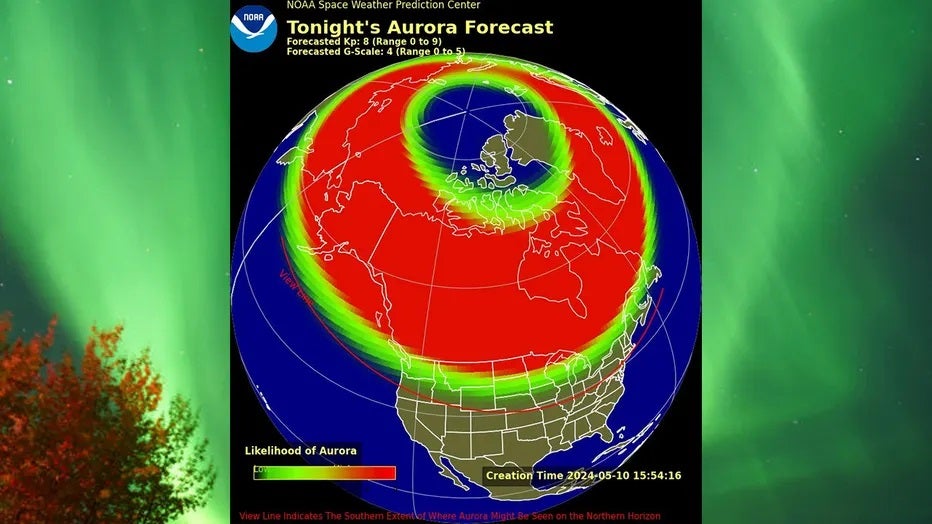Northern lights forecast for PA, NJ and DE; G5 Severe Geomagnetic Storm Watch issued

Northern Lights in Delaware Valley?
FOX 29's Drew Anderson discusses the possibilities of seeing the Northern Lights in the Delaware Valley and the best way to view them with your camera or phone.
PHILADELPHIA - A strong solar storm may make the northern lights visible to millions in the U.S. on Friday - including some in or near Pennsylvania, New Jersey, and Delaware. But those same solar flares that could bring skygazers around the area a glimpse of the aurora borealis could also potentially disrupt communications this weekend.
The National Oceanic and Atmospheric Administration issued a rare Severe (G5) Geomagnetic Storm Watch beginning Friday and lasting all weekend. The watch was the first of its kind issued in nearly 20 years.
According to NOAA, a large sunspot cluster has produced several moderate to strong solar flares since Wednesday.
At least five of those flares were associated with CMEs, or coronal mass ejections, which are explosions of plasma and magnetic fields from the sun’s corona. The CMEs that were spotted appear to be directed toward earth and could trigger geomagnetic storms.

(NOAA)
"Geomagnetic storms can impact infrastructure in near-Earth orbit and on Earth’s surface, potentially disrupting communications, the electric power grid, navigation, radio and satellite operations," NOAA officials said on their website. "Space Weather Prediction Center has notified the operators of these systems so they can take protective action."
The rare flares seem to be associated with a sunspot that’s 16 times the diameter of Earth. In 2003, an extreme geomagnetic storm knocked out power in Sweden and damaged power transformers in South Africa.
"Geomagnetic storms can also trigger spectacular displays of aurora on Earth," officials continued. "A severe geomagnetic storm includes the potential for aurora to be seen as far south as Alabama and Northern California."
Currently, NOAA’s aurora forecast for Friday night places the southern extent of where the northern lights might be seen in our region just north of the Maryland / Pennsylvania line.
G5 (Severe) Geomagnetic Storm Impact for Pennsylvania, New Jersey, and Delaware
Power systems: Possible widespread voltage control problems and some protective systems will mistakenly trip out key assets from the grid.
Spacecraft operations: May experience surface charging and tracking problems, corrections may be needed for orientation problems.
Other systems: Induced pipeline currents affect preventive measures, HF radio propagation sporadic, satellite navigation degraded for hours, low-frequency radio navigation disrupted, and aurora has been seen as low as Alabama and northern California (typically 45° geomagnetic lat.).
WEATHER
It'll be too cloudy for the Delaware Valley to see the Northern Lights Friday night and into Saturday morning.
There should be clear skies to see the Northern Lights, and skies in the region won’t clear until 3 or 4 a.m.
Additionally, the Northern Lights often don't last past 2 a.m., so the odds for viewing across the area are very slim.
But, don't worry, there will be more opportunities to see them in the coming years.
MORE CHANCES
The sun is in an active cycle where it can fire off big blasts of charged energy this way.
The sun constantly sends charged energy. Some of that spills into the sky around the North Pole, where Earth's magnetic field comes together.
That charged energy interacts with air way up in the sky to create the Northern Lights near the North Pole.
When much bigger blasts of that charged energy sun hits Earth, the Northern Lights move farther south.
So the next time you hear a "G4" geomagnetic storm, and our skies are clear, head out after sunset through 1 a.m. and start taking pictures.
A lot of times, you won't see the Northern Lights with your own eyes around here, but your camera will.
Take a night sight picture (a picture with a long exposure time) for the Northern Lights to show up on your phone.
If you happen to be up late tonight, go out when the skies are clear and take some pictures. It's unlikely the Northern Lights will still be around, but it's worth a shot if you're up.
The Associated Press contributed to this report.

